May 7, 2022
World Premiere at New Danish Museum Exhibition

Around 78 million years ago, a previously unknown dinosaur species, roughly the size of a rhinoceros, roamed the Earth. A research team has studied the dinosaur in detail and chosen to name the species after a god from Norse mythology. The dinosaur’s exceptionally well-preserved fossilized skull will soon be exhibited in Denmark.
This summer, for the first time, the public outside the small group of researchers who have been studying the remarkable find over recent months will be able to see the previously unknown dinosaur when the real fossil is exhibited at the 'Knuthenborg Natural History Collection' on Lolland.
Due to the dinosaur's distinctive appearance, the research team has chosen to name it after a Norse god. When the newly discovered dinosaur species with its Nordic-sounding name arrives in Denmark at the end of May, it will be in a transport crate that will remain partially closed until the team’s scientific study is published. Visitors will therefore have only a glimpse inside the crate until early July, when the entire dinosaur is revealed.
Until then, the research team is keeping details, including the name and precise appearance, under wraps, as it’s extremely rare for researchers to have the opportunity to name an entirely new dinosaur species.
The newly discovered species was found in the northern part of Montana, USA, where it lived during the Cretaceous period, between 66 and 145 million years ago, the same era that saw the reign of the famous Tyrannosaurus Rex.
A Sensation on Danish Soil
Danish paleontologist Jesper Milan, museum curator at Geomuseum Faxe, who has a Ph.D. focused on dinosaur footprints, is excited to see the new species.
“It’s unprecedented for a newly discovered dinosaur species to be exhibited on Danish soil. I would even go so far as to call it a sensation. Just finding a new dinosaur species is unique, and when it’s as intact as this specimen, it’s something that happens only once or twice a year globally,” says the dinosaur expert, adding:
“As a dinosaur nerd, it’s pure joy to see a new, unknown dinosaur species come to Denmark, especially one named after a Norse god. I think it’s fantastic.”
300 Million Years of Animal Life on Earth
The dinosaur will join the newly opened 'Knuthenborg Natural History Collection' at Knuthenborg Safari Park, which presents more than 300 million years of animal history.
Here, visitors can explore Europe’s largest collection of genuine fossils from the Permian period, as well as fossils from the dinosaur era. This includes the world’s best-preserved Allosaurus, known as 'Big Joe,' which is 95 percent intact. Over the summer of this year and 2023, even more dinosaurs will be added to the exhibition.
“It’s amazing to think about the cycles of animal life that have occurred over millions of years. Our goal with these rare fossils is to give guests knowledge of nature’s evolution from Earth’s ancient history, through the age of dinosaurs, and draw connections to the animals living today,” says Knuthenborg Safari Park’s owner and director, Christoffer Knuth.
When the newly discovered dinosaur species goes on display, Knuthenborg Safari Park will make the fossil available to researchers, as is the case with other fossils in the exhibition. In winter, the fossil of the unknown dinosaur will be exhibited at a museum in the United States.
FACT BOX: The Unknown Dinosaur Species With a Nordic Name
- Lived between 79.5 and 78.2 million years ago during the Cretaceous period.
- Name and appearance will be revealed in July when the scientific study behind the discovery has been peer-reviewed.
- Replicas of the dinosaur will be exhibited in both the USA and Canada this summer.
- The dinosaur will be permanently displayed at the Knuthenborg Natural History Collection, where the evolutionary history of large animals over millions of years is showcased.
- The collection includes Europe’s largest collection of animals from the Permian period and will expand over the coming years to become Europe’s leading exhibition of real dinosaurs.
- The research behind the unknown dinosaur species is led by Associate Professor Mark Loewen, Department of Geology and Geophysics, University of Utah, & Resident Research Associate, Natural History Museum of Utah.
- In Denmark, research oversight is provided by paleontologist Jesper Milàn, museum curator at Geomuseum Faxe, and Knuthenborg’s own paleontologist, Anna Øhlenschlæger.
Assets approved for media use.
Click here